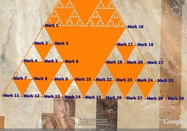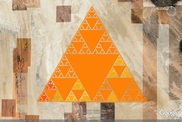|
Teacher Downloads
|
Pyramid in the Desert
Objectives
Lesson Description This lesson introduces students to the concept of fractals with a simple fractal curve. The Sierpinski Triangle is a basic example of fractals because it uses the familiar triangle with a pattern that shows self-similarity at any scale. Starting with a blank equilateral triangle, the middle fourth of the triangle is found by joining the midpoints of each side in a shaded triangle. Each repetition of this process constitutes a stage of the fractal. The Google Earth Kmz download offered above will originally be used by the teacher only. The file includes the vertices and polygons of a partially completed Sierpinski triangle. Students will add to this triangle by continuing the pattern for 3-4 stages for the incomplete triangles. There are 18 vacant triangles in the included file (as shown below left); their coordinates are listed on the Teacher Sheet download.. The vertex coordinates or placemarks of these triangles can be assigned to students so that the entire class is contributing to the finished product. The Student Worksheet download is a pdf file for this purpose. The students will create folders in Google Earth to store the placemarks and triangle polygons they create. They should submit their finished Google Earth files to the teacher in organized folders, preferably with the triangles arranged by fractal stage. The teacher will add the students' triangles to the master folder and then share the completed project with everyone. Note that individual pieces of the given triangle can be removed or added in the file if needed, and the triangle can be expanded in subsequent years by other students as an ongoing creation. Discussion should follow as to what properties fractals have and theories of how they can be used. Additionally, students should try to express the pattern mathematically. This is best done with by describing the area of the triangle that is NOT shaded with fractions at different stages. These questions are included on the Student Worksheet download. You may find these links helpful:
|




